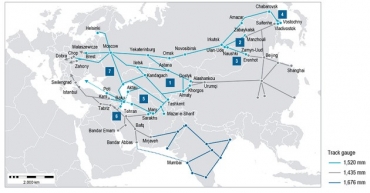The 2020 study was undertaken in collaboration with IEC (Infrastructure Economic Centre) consultancy based in Moscow and Paris and proposes:
- An analysis of major changes undergone over the last years on the Northern routes
- A volume forecast for the period up to 2030 based on existing macroeconomic background
- An analysis of the elasticity of the demand for rail freight transport in relation to the level of Chinese subsidies, the digitalisation of processes, border crossing improvements, speed of transit
UIC will organise an official presentation of the study results in the coming weeks and make the results available. In the meantime, we are pleased to propose hereunder a preview of some of the findings:
Volume assessment
In 2016-2018 the market has been growing actively, but in 2018 and especially in 2019 the dynamic changed from fast to moderate growth and volumes were estimated at 345.000 TEUs This resulted in active search for niche and balancing solutions by market players and further cooperation increase.
The ratio of westbound to eastbound transit traffic (transit only) was about 56,6% to 44,4% for all traffic and 67.6% to 32.4% for loaded containers.
Route utilisation
About 95% of Euro-Asian transit in both directions (and including Asia – Central Asia traffic) goes via Russia, whilst the remaining 5% is routed via the Middle corridor and other routes.
In 2018 75% of traffic transited through Dostyk – Brest, 15% via Zabaikalsk / Manzhouli, and the remaining 10% via Mongolia.
Forecast
Three macroeconomic scenarios were considered for the study: pessimistic (supposing trade wars and geopolitical tensions), baseline (supposing stabilisation of growth) and optimistic (supposing acceleration of growth rates of largest economies and further globalisation). The modelling is based on the baseline scenario.
The macroeconomic background under baseline scenario supposes favourable conditions for further growth of Eurasian traffic until 2030, but also increasing disbalance between eastbound and westbound traffic ranging between 42-43% to 58-57%.
The share of rail transportation in overall volumes is not likely to change much. In 2018 it varied from 0.1% to 9.1% for different European and Chinese regions and in 2030 it may grow to 1.0% - 9.8%.
Still the bottom and top volumes of the market in 2030 can vary: from less than 450 thousand TEUs under pessimistic scenario and unfavourable factors, such as a decrease of rail subsidies in China, to more than 2 m loaded TEUs in 2030 under optimistic scenario coupled with positive factors, such as digitalisation, infrastructure improvements and support measure for rail transportation.
These factors, infrastructural, operational and economic, were tested one by one with a model for this study.
Mitigating measures
IEC’s analysis recommends that the best solution to mitigate these difficulties is a coordinated joint work along ocean-to-ocean corridors, which can be an important part of international sustainable development policy.
The objective of the initiative is a development of rail transport along Eurasian corridors, from ocean to ocean, thanks to further integration of segments on 15200 mm and 1435 mm areas, including links to the Republic of Korea and Japan. It can raise the overall competitiveness of rail transport, also under unfavourable external conditions and help cope with inequality of flows in different directions thanks to creation of a balanced network of logistic hubs combining transit flows with exports and imports.
END News/
















